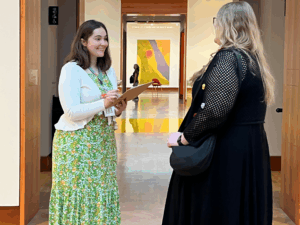When Anna Michalski stepped into the Chazen Museum of Art last fall, she wasn’t there just to admire the paintings. She arrived with an Excel mindset and a mission: help the museum better understand who’s coming to its events — and why.
“They basically said, ‘The Chazen wants to know more about who’s coming to events — and who’s not,’” Michalski recalled. “Who are they? Do they like the events? What do they want more of?”
These questions fueled Michalski’s yearlong project as part of UW–Madison’s accelerated master’s degree in arts and creative enterprise leadership. Run through the Bolz Center for Arts Administration, the program places students in embedded roles across Madison’s arts landscape. For Michalski, it meant diving headfirst into a complex audience data challenge.
Berit Ness, chief engagement officer at the Chazen, said Michalski’s placement was just the latest collaboration with Bolz Center students. Past projects have included student audience development and events programming connected to the Chazen Café. “The fresh perspectives and dedicated work of students like Anna bring inquiry and analysis that truly improves our understanding of our community,” she said.
Arts and numbers
Michalski’s twin interests in art history and analytics may seem uncommon, but it feels natural to her. “Honestly, I’ve always been kind of a nerd about tracking things,” she said. “Movies I’ve watched, books I’ve read — I like to analyze what I take in. People think that the arts and numbers don’t go together. I’ve tried really hard this year to make them go together,” she said.
Together, Michalski and Chazen staff members decided to focus on standardizing data collection, analyzing demographics and satisfaction of event attendees, and tracking event marketing efforts.
Michalski first conducted an audit of existing audience data collection—everything from event post-signup surveys to informal feedback—and found there were inconsistencies and gaps. “Something I was really big on was if we really want to know the answers to these questions, we need to ask them the same way, and we need to ask them for every event,” she said.
From there, Michalski spearheaded the implementation of post-event satisfaction surveys. “Everyone who registers for the event receives a follow-up email that links to a survey,” she explains. Keeping it short was key to maximizing responses. “We tried to keep it really brief, because we wanted as many people as possible to answer.” The response rate, with six hundred replies across the year’s events, provided a valuable snapshot of attendee experiences.

Bolz Center for Arts Administration graduate student Anna Michalski (left) surveys a gallery visitor as part of her year-long project studying audiences at the Chazen Museum of Art.
Face to face
Venturing beyond digital data, Michalski took to the museum floors, conducting in-person surveys. “I stood in the galleries, and interviewed every third visitor,” she noted, emphasizing the importance of mitigating bias. “If they said they hadn’t attended an event before and they lived in Madison, I asked why not, and it was really interesting,” she said. “I was surprised. The most common reason people gave is they don’t have anyone to go with and they’re afraid to go alone.” That social context helped the Chazen see its audiences through a more empathetic lens.
She also challenged assumptions about who was attending. “I assumed we’d see a ton of students,” she admitted. “But across most general events, the audience is really balanced, with many attendees from the broader Madison community.”
Tracking what works
Perhaps the most complex piece of her work focused on tracking marketing effectiveness. “We created individual links so we could tell who was clicking to register and if that was converting into any tickets sold,” she explained. This involved a deep dive into social media, QR codes, and website analytics. While the website appeared to be a significant driver, Michalski observed, “I think that’s because a lot of people probably see something on social media or see it a few times, they don’t click the link, but it’s in their head, and then they Google it and go to the website. It’s harder to track what led them to the website.”
Some findings were relatively predictable — Facebook remained a strong performer — while others surprised her. One event saw an unusual number of sign-ups through Threads, Meta’s fledgling social platform. “We were all like, ‘Who are these people on Threads? Why this event?’ ”
Takeaways
But the biggest takeaway wasn’t tied to any one platform. “You can’t really give one channel full credit,” Michalski said. “People might see a post on Instagram, think about it, then Google it days later and register on the website. That last click doesn’t tell the whole story.”
Looking ahead, Michalski sees a promising intersection of her art history training and analytical skills in the job market. “I think it is a thing that is not as popular in the arts yet,” she observes, particularly within smaller organizations. “They might feel like they don’t have the bandwidth to do that. So I really become interested in ways to make it automated, or semi-automated, so there’s very little upkeep after setting it up,” she said.
For the Chazen, Michalski’s yearlong data dive has provided more than just numbers. It has illuminated a clearer picture of its audiences, fostering a deeper understanding of who walks through its doors.
“Working with the Bolz Center and having Anna embedded in our team has been so helpful,” Ness said. “Her work helped us ask smarter questions, and she helped us build tools to start finding some answers.”